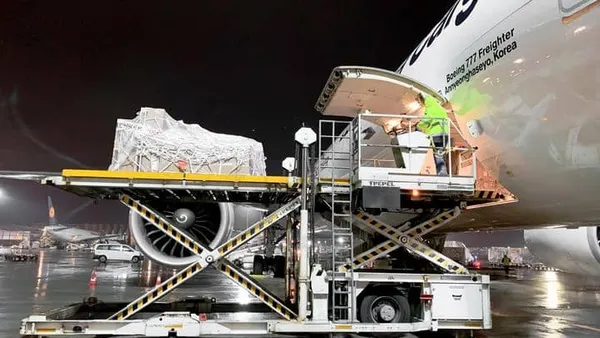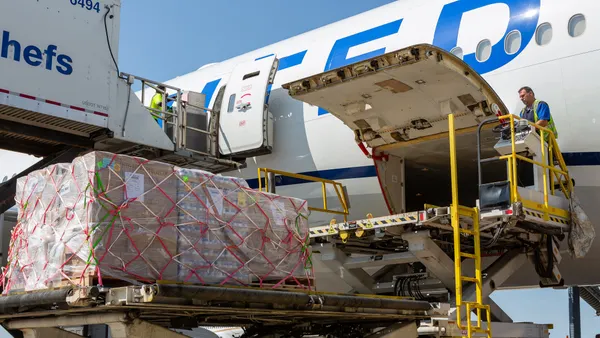Dive Brief:
- Demand for airfreight continued to show a strong recovery, growing 1% in June compared to the same month in 2019, despite the fact that capacity has yet to return to pre-pandemic levels, according to the latest data from Clive.
- Demand for airfreight cratered in the early days of the pandemic, and growing above a 2019 level indicates a return to normal levels of demand. Clive's figures show demand grew 36% YoY. Airfreight capacity was up 31% YoY, but is still down 22% from 2019 as belly capacity has yet to return.
- Rates from Hong Kong to the U.S. fell nearly 24% from a mid-May peak to reach $7.24 per kilogram as of Monday, according to figures from the TAC Index. But rates are still high in historic terms, up nearly 69% YoY and 119% compared to the same point in 2019.
Dive Insight:
The airfreight market remains dominated by freighter companies like FedEx, UPS and Cathay Pacific as passenger flights have yet to return to early 2020 levels. And when passenger travel does return, it likely won't be adding capacity to the transpacific at first, according to a recent note by Peter Stallion, head of air and containers at Freight Investor Services.
"Looking forward into the near-term market, a lot still rides on the return of long-haul travel, most likely impacting transatlantic routes first before the Asia market," Stallion wrote, later adding that, "Owned charter capacity is still king."
And the companies that currently own that capacity don't expect the demand for their services to decline any time this year.
"We expect air cargo capacity to remain constrained through at least the first half of calendar year 2022," FedEx Chief Marketing and Communications Officer Brie Carere said at the end of last month. "Recovery will be slow, potentially episodic, and a full recovery is not anticipated until 2024."
This will mean that pricing for airfreight will remain in FedEx's favor at least into next year, Carere said. FedEx plans to add 20 additional Boeing 767 Freighters to its fleet by the end of 2025 to keep up with the demand for its international services.
As Stallion pointed out, many companies turned to the charter market when the pandemic led to the loss of belly capacity. Atlas Air, which has provided some of those charter planes, expects some of those customers to remain even when that belly capacity returns as they've learned not the rely on the stability of the passenger market, Atlas Air CEO John Dietrich said in May.
"What many of our customers are seeing and learning is that main deck freighters is very attractive," Dietrich said. "And to be able to secure that capacity is important both within this pandemic environment, but also beyond."
The airfreight market has also benefited from the ongoing congestion in the ocean market as cargo owners look for a quicker alternative, experts have observed. And as ocean capacity has become more expensive, it has made the price of air freight easier to rationalize. According to The International Air Transport Association, "air cargo was more than 12 times more expensive than ocean shipping prior to the crisis, but this has fallen to a ratio of 6 in May 2021."
This has resulted in companies using airfreight for goods not typically transported via plane, according to Brian Bourke, the chief growth officer at Seko Logistics.
"We've shipped hot tubs, we've shipped bikes, we've shipped leaf blowers, I believe, all things that typically would not go via airfreight we are moving via airfreight," Bourke said on a media call at the end of last month. "Even grills."














